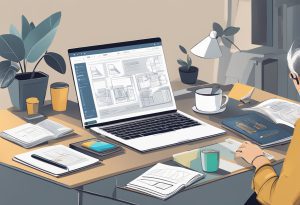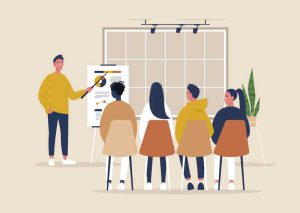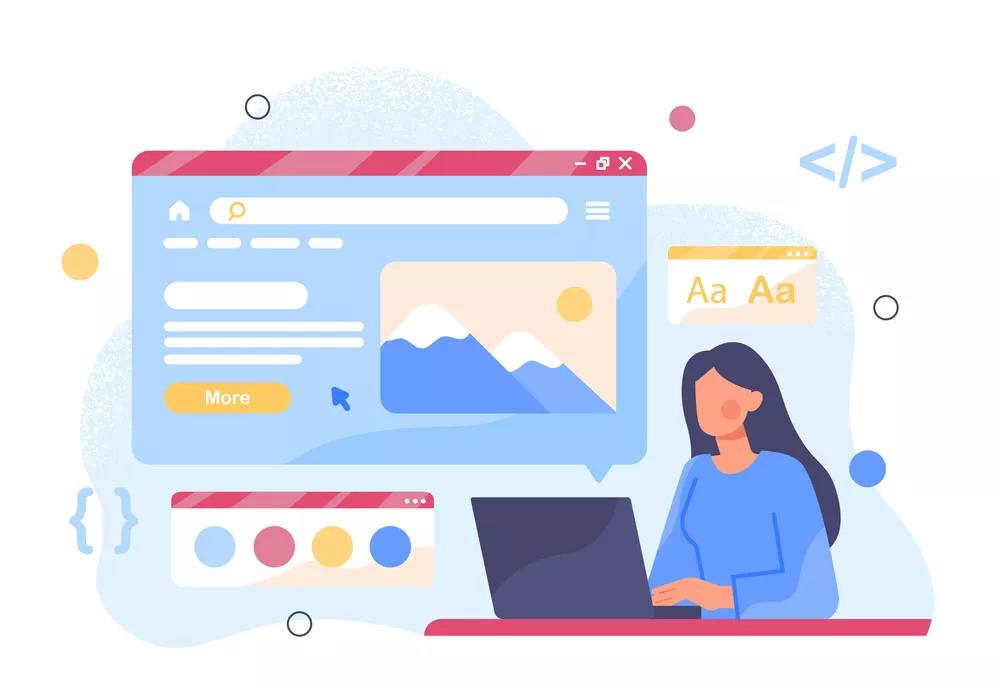To understand how to become a UX designer, begin by gaining a solid foundation in design, psychology, or human-computer interaction through formal education or specialised training. Build a strong portfolio by working on real-world projects, internships, or personal design challenges. Continuously improve your skills by mastering industry tools, staying updated on trends, and gaining practical experience to secure your first role in UX design.
What Are the Different Types of UX Designers?
UX or user experience is the process of designing services that provide meaningful and relevant experiences for users. Depending on their specialization, there are several main types of UX designers:
- Interaction Designer (IxD): Focuses on interaction processes, concentrating on control design and display elements like buttons, menus, and navigation systems. Interaction designers aim to facilitate usability and enhance the overall user experience.
- Visual Designer: Deals with the graphical aspects of a product, including layout, colours, fonts, and overall structure. Visual designers ensure that the product is not only functional but also visually engaging.
- User Researcher: Focuses on analysing the problems users face and understanding the solutions they need, often through interviews and surveys. User researchers gather valuable insights that inform the design process, helping create products that meet users’ needs. Their work overlaps with that of Interaction Designers and Information Architects, as all contribute to user-centred design.
- Information Architect (IA): Specialises in studying a product’s organisational structure. Information architects focus on arranging content in a way that makes it easy to navigate, creating sitemaps, user flows, and wireframes that guide users through the product.
- Usability Analyst: Studies the usability of products through testing and analysis methods. Usability analysts identify usability issues and recommend improvements to enhance the user experience.
- UX Writer: Concentrates on the content within a product, such as labels for buttons, error messages, or instructional text. UX writers ensure that the text is clear, consistent, and aligned with the product’s overall purpose.
- Service Designer: Takes a holistic approach, considering the entire user journey across multiple service platforms and interactions. Service designers aim to create coherent and seamless experiences for users throughout their entire engagement with a service or brand.
Each type of UX designer brings unique skills and expertise to the table. This diversity offers a wide range of career paths, enabling you to choose a route that aligns with your aspirations and interests.
What does a UX designer do?
UX designers specialise in creating user-centred designs to enhance the product experience. Their duties may vary depending on their specialisation. Below are some of the most common responsibilities of a UX designer include:

- User Research: UX designers begin the design process by researching their target users to understand their needs, behaviours, and pain points. This involves conducting interviews, surveys, focus groups, and usability testing. Gathering these insights helps designers identify problems and opportunities for improvement. Understanding users early ensures the product is aligned with their expectations.
- Creating User Personas: Based on research, UX designers develop user personas that represent different segments of the target audience. These personas help guide design decisions by providing a clear picture of the users’ goals, behaviours, and challenges. Keeping these personas in mind throughout the design process ensures the product meets real user needs. Personas make designs more user-centred and relevant.
- Developing Information Architecture: UX designers structure the content of a product in a logical and intuitive way to make navigation easy. This involves creating sitemaps, user flows, and organising information to reduce friction for users. A well-developed information architecture ensures that users can find what they need quickly and efficiently. Clear organisation of content helps users navigate products with ease.
- Designing Wireframes and Prototypes: UX designers create wireframes to visually represent the structure of a product, and interactive prototypes to test the user flow. Wireframes provide a basic blueprint, while prototypes allow for early testing of features and interactions. These designs help to visualise how the final product will function and highlight areas for improvement. Prototyping helps refine ideas before development begins.
- Collaborating with Cross-Functional Teams: UX designers work closely with UI designers, developers, product managers, and other stakeholders to ensure design decisions are practical and align with business objectives. Collaboration helps create designs that are both user-friendly and feasible to implement. Regular communication between teams ensures that all perspectives are considered throughout the design process. Effective teamwork leads to more successful product outcomes.
- Conducting Usability Testing: After developing prototypes, UX designers conduct usability testing to evaluate how users interact with the product. This involves observing users as they complete tasks and gathering feedback on their experience. Usability testing helps identify pain points, usability issues, and areas for improvement. It allows designers to make informed adjustments based on real user input.
- Iterating on Designs: Based on the results of usability testing, UX designers refine and improve their designs to enhance user satisfaction. This iterative process involves making adjustments to features, layouts, or interactions. Each round of testing provides valuable insights to optimise the user experience. Iteration ensures that the final design meets users’ needs and business goals more effectively.
- Staying Updated on Industry Trends: UX designers thrive on innovation and must stay abreast of emerging trends, tools, and technologies. This continuous learning is essential to refining their craft and delivering the best possible user experiences.
UX designers play a crucial role in ensuring user engagement and satisfaction. By shaping how users interact with products, they significantly enhance the overall experience.
Average UX Designer Salary
Salaries for UX designers can vary widely based on experience, location, and the specific industry in which they work. Here’s an overview of typical earnings for UX designers in the UK:
- Entry-Level Pay for UX Designers: Entry-level UX designers typically earn upwards of £25,000, with some internships or junior roles starting around £35,000. At this stage, designers are usually given more minor assignments and are expected to take on some of the quieter tasks of senior designers while they gain experience.
- Mid-Level Pay for UX Designers: Mid-level UX designers generally earn between £35,000 and £55,000. This is a solid pay range for professionals at this stage, as they often lead design teams or contribute to important projects that involve supervising or mentoring junior designers.
- Senior UX Designer Salaries: Senior UX designers, particularly those with niche expertise or extensive experience, can earn from £55,000 upwards, with some positions offering salaries over £80,000. In senior roles, designers are expected to mentor junior staff, lead larger design teams, and take on more complex and strategic responsibilities.
- UX Managers and Directors: UX managers and directors in senior positions can earn over £80,000, depending on the level of responsibility, the size of the company, and the sector in which they work.
Essential Skills of a UX Designer
UX designers require a combination of technical, analytical, and interpersonal skills. Key skills required for UX designer include:

- User Research Skills: These enable a UX designer to gain insights into users’ needs, preferences, and behaviours by focusing on research processes. UX designers must be familiar with a variety of research methods and techniques to gather valuable data.
- Design Thinking: UX designers need to adopt a design thinking mindset, understanding users’ needs and approaching problems as solvable challenges to be addressed through creative solutions.
- Wireframing and Prototyping: Proficiency in wireframing and prototyping tools (such as Sketch, Figma, or XD) is essential for conceptualising and testing design ideas effectively.
- Information Architecture: UX designers should be skilled in developing sitemaps and user flows. A strong understanding of how to structure and organise information is key to creating a more intuitive and seamless user experience.
- Usability Testing: Knowledge of usability testing is crucial, as it helps UX designers assess how well their designs work in real-world scenarios and identify areas for improvement.
- Communication and Collaboration: Strong communication skills are vital for working effectively with cross-functional teams and presenting ideas to stakeholders or clients.
- Attention to Detail: Precision is essential in UX design, as even small errors in design can negatively affect the user experience. A poorly designed interface can lead to frustration and a lack of engagement.
UX Designer Tips
Here are some essential tips for becoming a successful UX designer:
- Pursue Relevant Education: Obtaining a background in design, human-computer interaction, or psychology can be beneficial. Education helps you acquire valuable expertise and skills that are essential for a UX designer.
- Build a Strong Portfolio: A well-curated portfolio is crucial for showcasing your work. It should include major projects, research design processes, and case studies. Make sure your portfolio is polished and compelling to attract potential employers.
- Gain Practical Experience: Seek internships, volunteer opportunities, or your first job in a company where you can work on UX design projects. Practical experience will help you refine your skills and further enhance your portfolio.
- Learn Industry Tools: Familiarise yourself with key design tools such as Figma, Sketch, Adobe XD, and InVision. Mastery of these tools is essential for efficient and professional UX design work.
- Stay Updated on Trends: Subscribe to design blogs, online articles, and courses to stay informed about the latest industry trends, topics, and best practices shaping the future of UX design.
- Earn Professional Connections: Network with other UX designers, attend industry events, and join professional organisations. Building connections can help you find job opportunities or mentorship.
- Cultivate a Sense of Empathy: Always prioritise empathy for users in your design process. Users are at the heart of every product, so understanding their needs, pain points, and preferences should always guide your design decisions.
Requirements For UX Designer
There are specific qualities and abilities that anyone wishing to become a UX designer should possess. Here’s what you’ll need to start a career as a UX designer:

- Academic Qualifications: While formal education is not always essential, a background in design, human-computer interaction, or a related field can provide a strong foundation. It helps you understand key principles and concepts. Having relevant qualifications can give you an edge over other candidates.
- Design Experience: Internships, volunteer work, or entry-level positions may not seem glamorous, but they are crucial for gaining practical experience. These roles help you apply theoretical knowledge in real-world settings. They also provide opportunities to refine your skills and build a portfolio.
- A Strong Portfolio: A well-crafted portfolio that showcases your best work is essential for securing a job in UX design. It should highlight your design process, problem-solving abilities, and final results. A strong portfolio demonstrates your capability to potential employers and clients.
- Skills: Proficiency with design tools such as Figma, Sketch, or Adobe XD is critical in UX design. You will need to create wireframes, prototypes, and high-fidelity visuals. Mastery of these tools will allow you to effectively communicate design ideas and execute projects.
How to Become a UX Designer
Here’s a step-by-step guide to becoming a UX designer:

- Education: Start by earning a degree in design, technology, psychology, or a related field. This provides foundational knowledge for UX work. Consider specialised training in UX design to further hone your skills.
- Portfolio Development: Create a strong portfolio showcasing your best work. Include case studies that demonstrate your design process, from problem identification to solution. A well-crafted portfolio is key to impressing employers.
- Experience: Look for internships, volunteer work, or entry-level UX roles. These hands-on experiences allow you to apply what you’ve learned in real-world projects. They also help you build a strong portfolio and gain confidence.
- Important Tools: Get familiar with industry-standard design tools like Figma, Sketch, Adobe XD, and InVision. Mastering these tools is essential for creating wireframes, prototypes, and final designs. They are key to your day-to-day work as a UX designer.
- New Knowledge: Stay up-to-date with the latest trends by reading UX blogs and articles. Participate in online and offline UX communities to learn from others. This will help you stay informed about best practices and new tools.
- Find Mentors: Connect with experienced UX designers through networking events, conferences, or professional organisations. A mentor can offer valuable guidance and insights. Building these relationships can also lead to job opportunities.
- Build Empathy: Always design with the user in mind. Understanding users’ needs, pain points, and goals is crucial for creating effective UX. Empathy ensures you design intuitive and meaningful experiences.
- Apply for UX Designer Positions: Once you have the right qualifications and portfolio, start applying for UX roles. Look for positions in companies, agencies, or even freelance opportunities. This is the next step toward launching your career as a UX designer.
Get Qualified as a UX Designer
UX Design Certification, A Designer’s Guide to UX Research and Testing, UX Design Online Course, Essential UX Design Principles
Frequently Asked Questions
Why Should You Be a UX Designer?
Becoming a UX designer allows you to create impactful and user-centered experiences that enhance people’s interactions with technology and products. It’s a rewarding career that combines creativity, problem-solving, and a deep understanding of user needs. As a UX designer, you can significantly influence how users engage with digital platforms, making their experiences more intuitive and enjoyable.
Is a Career as a UX Designer Right for You?
If you love design, are interested in human behaviour, and have a passion for technology, then a career as a UX designer could be the perfect fit. This role is ideal for creative and collaborative individuals who are eager to learn and want to make a positive impact on the user experience.
How Much Can a UX Designer Expect to Get Paid?
Most junior UX designers earn between £25,000 and £35,000 per year. With several years of experience, salaries typically range from £35,000 to £55,000. Mid-level experts who hold senior or specialised roles can expect to earn between £55,000 and £80,000, depending on their skills and the industry. Senior UX leaders or highly experienced designers can earn upwards of £100,000 annually.
In What Areas Can I Gain Additional Skills That Will Help with Getting a UX Design Job?
While formal prerequisites are not strictly required, obtaining a degree in design, human-computer interaction, psychology, or a related field can be beneficial. Graduate certificates in areas such as UX design principles, user research methods, and usability testing can also add value and enhance your qualifications.
Do I Need to Have Experience to Start Working?
Having some experience is an advantage when starting your career as a UX designer, but it’s not essential. Many employers value a well-developed portfolio that demonstrates your ability to solve design challenges. Work experience from internships, freelance projects, or coursework in interaction design can help build practical skills and showcase your capabilities.
What Is the Employment Situation for UX Designers?
The employment outlook for UX designers is very promising. As more companies rely on digital products and services across various industries, the demand for skilled UX designers continues to grow. Organisations are increasingly prioritising customer satisfaction and user engagement, making experienced UX designers highly sought after.
UX Designer Hierarchy and Career Progression
UX designers typically start in junior roles, progress to mid-level positions, and then advance to senior roles. As they gain experience, they take on more responsibilities such as user research, interaction design, and usability testing. Many also transition into management roles, leading design teams and overseeing projects.
UX Designer Exit and Other Career Options
Experienced UX designers have several career paths to explore, such as product management, user research consulting, or instructional design. Some may choose to start their own UX consultancy, while others may transition into related fields like marketing, content strategy, or web development.


